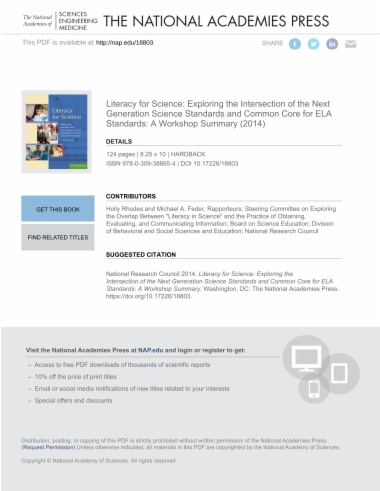

The recent movement in K-12 education toward common standards in key subjects represents an unprecedented opportunity for improving learning outcomes for all students. These standards initiatives - the Common Core State Standards for English Language Arts and Mathematics (CCSS) and the Next Generation Science Standards (NGSS) - are informed by research on learning and teaching and a decade of standards-based education reform. While the standards have been developed separately in English/Language Arts and Science, there are areas where the standards intersect directly. One such area of intersection occurs between the "Literacy in Science" portions of the Common Core State Standards for English/Language Arts and the practices in the NGSS (originally outlined in the NRC's A Framework for K-12 Science Education), particularly the practice of "Obtaining, evaluating and communicating information".
Because the CCSS literacy in science standards predated the NGSS, developers of the NGSS worked directly with the CCSS team to identify the connections between the two sets of standards. However, questions about how the two sets of standards can complement each other and can be used in concert to improve students' reading and writing, as well as listening and speaking, in science to learn science continue to exist.
Literacy for Science is the summary of a workshop convened by the National Research Council Board on Science Education in December 2013 to address the need to coordinate the literacy for science aspect of CCSS and the practices in NGSS. The workshop featured presentations about the complementary roles of English/language arts teachers and science teachers as well as the unique challenges and approaches for different grade levels. Literacy for Science articulates the knowledge and skills teachers need to support students in developing competence in reading and communicating in science. This report considers design options for curricula and courses that provide aligned support for students to develop competencies in reading and communicating, and addresses the role of district and school administrators in guiding implementation of science and ELA to help ensure alignment. Literacy for Science will be a useful point of reference for anyone interested in the opportunities and challenges of overlapping science and literacy standards to improve the learning experience.